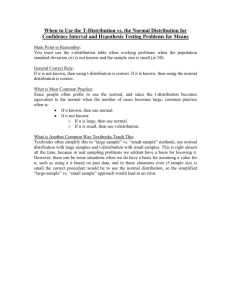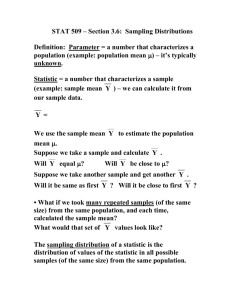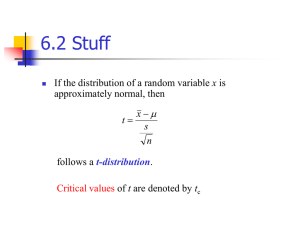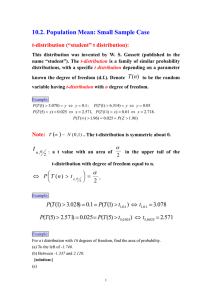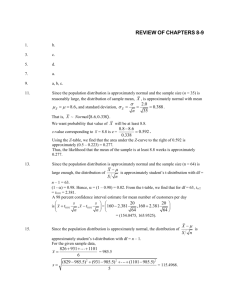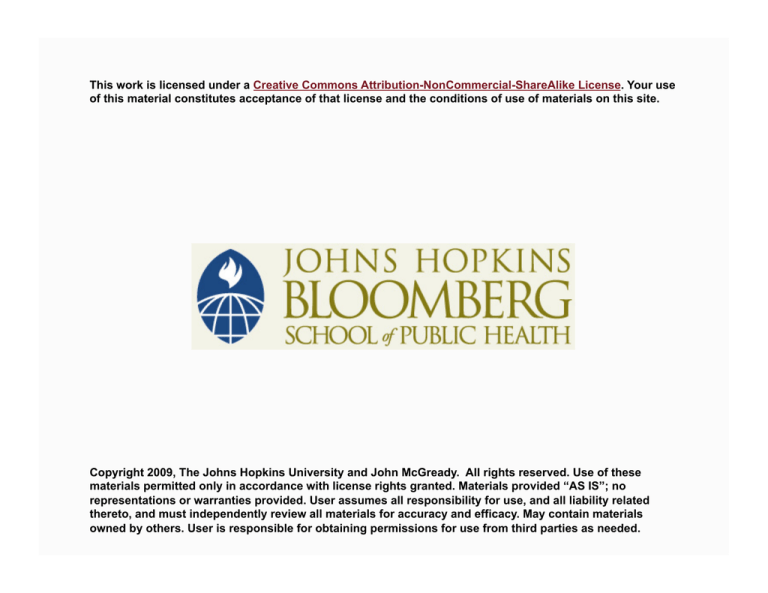
This work is licensed under a Creative Commons Attribution-NonCommercial-ShareAlike License. Your use
of this material constitutes acceptance of that license and the conditions of use of materials on this site.
Copyright 2009, The Johns Hopkins University and John McGready. All rights reserved. Use of these
materials permitted only in accordance with license rights granted. Materials provided “AS IS”; no
representations or warranties provided. User assumes all responsibility for use, and all liability related
thereto, and must independently review all materials for accuracy and efficacy. May contain materials
owned by others. User is responsible for obtaining permissions for use from third parties as needed.
Section D
True Confessions Biostat Style: What We Mean by
Approximately Normal and What Happens to the Sampling
Distribution of the Sample Mean with Small n
Recap: CLT
So the CLT tells us the following: when taking a random sample of
continuous measures of size n from a population with true mean µ
and true sd σ the theoretical sampling distribution of sample means
from all possible random samples of size n is:
µ
3
Recap: CLT
Technically this is true for “large n”: for this course, we’ll say n >
60; but when n is smaller, sampling distribution is not quite normal,
but follows a t-distribution
µ
4
t-distributions
The t-distribution is the “fatter, flatter cousin” of the normal:
t-distribution is uniquely defined by degrees of freedom
µ
5
Why the t?
Basic idea: remember, the true SE(
) is given by the formula
But of course we don’t know σ, and replace with s to estimate
In small samples, there is a lot of sampling variability in s as well:
so this estimate is less precise
To account for this additional uncertainty, we have to go slightly
more than
to get 95% coverage under the sampling
distribution
6
Underlying Assumptions
How much bigger the 2 needs to be depends on the sample size
You can look up the correct number in a “t-table” or “tdistribution” with n–1 degrees of freedom
7
The t-distribution
So if we have a smaller sample size, we will have to go out more
than 2 SEs to achieve 95% confidence
How many standard errors we need to go depends on the degrees of
freedom—this is linked to sample size
The appropriate degrees of freedom are n – 1
One option: you can look up the correct number in a “t-table” or
“t-distribution” with n – 1 degrees of freedom
8
Notes on the t-Correction
The particular t-table gives the number of SEs needed to cut off 95%
under the sampling distribution
9
Notes on the t-Correction
You can easily find a t-table for other cutoffs (90%, 99%) in any stats
text or by searching the internet
Also, using the cii command takes care of this little detail
The point is not to spend a lot of time looking up t-values: more
important is a basic understanding of why slightly more needs to be
added to the sample mean in smaller samples to get a valid 95% CI
The interpretation of the 95% CI (or any other level) is the same as
discussed before
10
Example
Small study on response to treatment among 12 patients with
hyperlipidemia (high LDL cholesterol) given a treatment
Change in cholesterol post–pre treatment computed for each of the
12 patients
Results:
11
Example
95% confidence interval for true mean change
12
Using Stata to Create Other CIs for a Mean
The “cii” command,
13


